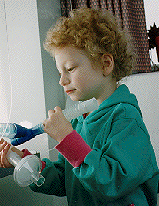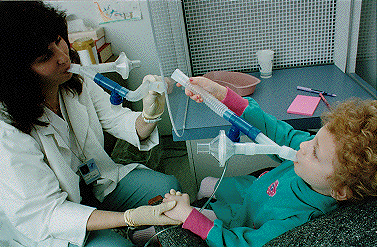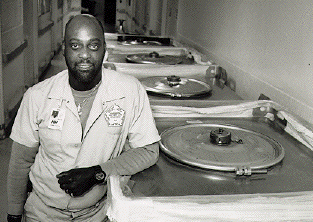
| Home | Contact Us | Site Map | Search |
 |
||||
|
|
|
|
|
| |
|
|
This file is provided for reference purposes only. It was current when it was produced, but it is no longer maintained and may now be out of date. Persons with disabilities having difficulty accessing information may contact us for assistance. For reliable, current information on this and other health topics, we recommend consulting the NIH Clinical Center at http://www.cc.nih.gov/.
|
|

|
Clinical Center News, Building 10, Room 1C255, National Institutes of Health, Bethesda, Maryland 20892. (301) 496-2563. Fax: 402-2984. Published monthly for CC employees by the Office of Clinical Center Communications, Colleen Henrichsen, chief. News, articles ideas, calendar events, letters, and photographs are welcome. Deadline for submission is the second Monday of each month. |
Five of 1996's weekly noon-time presentations will be broadcast live by satellite to medical schools around the country. The program, which includes telephone hookups so viewers can question presenters about their topics, has been drawing a growing number of audience members since the pilot broadcast last November.
Dr. Steven Rosenberg, NCI's chief of surgery, discussed immunotherapy and gene therapy for cancer, and Dr. Mark Hallett, NINDS clinical director, spoke on dystonia during the broadcast rounds on Feb. 14. More than 120 viewers from 27 medical schools pulled up to local televisions for that broadcast. Nearly 250 were on hand when the presentations were rebroadcast.
The Clinical Center's collaboration with CenterNet supports a shared commitment to providing professional information and education for health-care practitioners, says Dr. John I. Gallin, CC director. "The Clinical Center is the nation's model for clinical research. Televising our grand rounds offers us another opportunity to interact with colleagues and to help medical students learn more about the conduct and importance of clinical research."
The project is made possible through the technical expertise of the video section of the medical arts and photography branch, NCRR. "We handle the technical direction and camera operation and set up our portable studio," explains Ken Ryland, video section chief. About a thousand feet of video and audio cable connected Lipsett Amphitheater, where the lectures are presented, to the video section's B1 master control room, he said, a facility the section added in 1994.
From there the signal is sent by fiber-optic cable to the Washington International Teleport in Virginia for uplinking to the satellite. "That's the main dish farm for Washington," Ryland points out. "NBC and CNN uplink to the satellite from there, too."
This direct satellite link offers CC and NIH staffers a way to rapidly and broadly communicate. "It's a great way to reach the scientific community at a large number of sites across the country and worldwide," he says, "and it's cost-effective. Bringing in a satellite truck can cost more than $7,500. With our inhouse fiber-optic link, the satellite feed costs about $1,500."
The next session to be broadcast will be on April 10. Presenters are Dr. Judith Rapoport, chief of NIMH's child psychiatry branch, and Dr. Philip Pizzo, chief of pediatrics and head of the infectious diseases section for NCI. Dr. Rapoport's topic is "Childhood Hyperactivity: Behavioral and Brain Imaging Studies." Dr. Pizzo will speak on "Approaching the Treatment of Children with HIV Infection."
Also on the schedule are:
June 12, Dr. Carmen Allegra, chief of the NCI/Navy Medical Oncology Branch,
"Therapies for Colorectal Carcinoma," and Dr. Stephen Epstein,
chief of NHLBI's cardiology branch, "Potential Role of
Cytomegalovirus in Restenosis and in Atherosclerosis."
Sept. 11, Dr. Stephen I. Katz, NIAMS director, "Skin Immunity System: Why Study It?" and Dr. Arnold C. Slavkin, NIDR director, "What is in a Face: Enter Gene-Based Craniofacial-Oral-Dental Diagnostics."
Nov. 13, Dr. Allen M. Spiegel, NIDDK intramural research division director, "Defects in G-Protein Mediated Signal Transduction: An Important Cause of Human Disease," and Dr. Richard D. Klausner, NCI director, "Tumor Suppressor Genes: Regulating Cell Behavior."

Breathing the drug Pentamadine through a nebulizer, Kaitlyn sits at a desk surrounded by plexiglass walls. This clear-walled box, called a laminar flow hood, exhausts drug and infectious particles from the treatment area. Pentamidine-one child says it tastes like the smell of dirty socks-will help protect Kaitlyn from life-threatening Pneumocystis carinii pneumonia. AIDS and cancer patients are particularly at risk for PCP.
Kathleen Sharkey, respiratory therapist in the Critical Care Medicine Department, coaxes Kaitlyn through her 30-minute treatment by holding an empty nebulizer-dubbed a neb-in her own mouth. It consists of a mouthpiece, filter, and exhaust hose specifically designed to deliver aerosol Pentamadine to the patient's lungs. Kaitlyn's neb is connected by clear plastic tubing to a flowmeter on the wall. Sharkey turns a nozzle on the flowmeter to adjust the amount of drug flowing to the nebulizer. The nebulizer makes the particles of the medication smaller, which enables deeper penetration in the lungs.
"In the beginning, it's real hard to get little kids to do this treatment," Sharkey says. "It tastes bad, and patients are often tired of being poked and stuck before they get here."
Kaitlyn and her mother, Arlie Brice, travel from Lexington, Kentucky, every month for the treatments. It's a difficult schedule for mom to arrange and Kaitlyn to adjust to, but Kaitlyn makes the best of her long-distance commute by playing matchmaker on the plane.
Kaitlyn has her seat belt off as soon as possible and walks up and down the aisle of the plane talking with the other passengers, says Brice, rolling her eyes and laughing. She'll ask people on opposite sides of the plane who they are, and then say, "OK, now you two be friends."
Making friends is one way to make therapy easier on adult and pediatric patients alike. That's why Sharkey provides some extra touches. Candy from a well-stocked jar (each patient's favorite flavor is kept on a list) removes the bad taste when the treatment is over. Pre-warmed blankets are tucked around those who feel chilly, and air-conditioning is adjusted for those who are hot. Markers, crayons, and heart-shaped pens are on hand for moments of inspiration-Sharkey's lab is decorated with dozens of pictures drawn by the many CC patients she has treated in the past four years.
Still holding an empty nebulizer in her own mouth, Sharkey continues to monitor Kaitlyn's progress while pretending to take the treatment herself. Their faces poised on opposite sides of the plexiglass divide, Kaitlyn and her therapist make googly eyes at each other and hold staring contests.
 Kaitlyn pulls the neb out of her mouth, shaking her blonde curls. She looks
like an angel with an attitude. "Am I doing a good job?" she
asks, her face squished up from the bad taste. "You're doing
great," Sharkey encourages. "Keep going."
Kaitlyn pulls the neb out of her mouth, shaking her blonde curls. She looks
like an angel with an attitude. "Am I doing a good job?" she
asks, her face squished up from the bad taste. "You're doing
great," Sharkey encourages. "Keep going."
Looking like two twilight-zone elephants, therapist and patient match plastic hose ends on either side of the clear compartment. A game of tag ensues with Sharkey trying to keep pace with the effervescent Kaitlyn.
Sharkey, who has a disabled child of her own, is particularly aware of the
importance of treating people with compassion and respect. "I
can't force anyone to inhale this stuff, so I find a way to encourage
them, particularly the children."
When a child refuses treatment, or has difficulty, she'll turn off the neb for a short break. They may sip water, or spit out the bad taste, and the pause gives the child a sense of control over what is happening. Soon after, Sharkey has her patientback on track, nebulizer in place, ready for the games to continue.
If a patient has a sore throat, or is nauseated from chemotherapy, the Pentamidine treatment is painful. Speaking with physicians and nurses to determine the best treatment time and to coordinate patient-care needs is a big part of Sharkey's job.
"To facilitate the treatment, I need to know what went on with the patient prior to coming here. Sometimes we can avoid a problem by changing the timing of the treatment. I schedule patients to make it easier for them to tolerate the therapy."
For some kids that simply means scheduling the therapy to coincide with favorite television shows. Distraction can make all the difference when working with children. For others, it means knowing what therapy or procedure comes before the Pentamidine treatment and working around that to lessen any anxiety or discomfort.
When Kaitlyn's therapy ends, she reaches into the candy jar looking for her favorite Tootsie Rolls, but this time finds, instead, a heart-shaped pin.
"Somebody told me it's your birthday," Sharkey whispers.
"Happy Birthday, Kaitlyn."
With the gold heart pinned in place, Kaitlyn spins on tip-toe to show off
the swirl of her new birthday dress and skips out of the room waving good
bye.
Sharkey pulls out the antiseptic spray and sterilizes her lab for the next patient.
Let the games begin.(by Laura Bradbard)
 Kathleen Sharkey, a respiratory therapist in the Critical Care
Medicine Department, gives a hand to patient Kaitlyn Blanchard as they link
nebulizer exhaust tubes during Kaitlyn's Pentamidine therapy.
Kathleen Sharkey, a respiratory therapist in the Critical Care
Medicine Department, gives a hand to patient Kaitlyn Blanchard as they link
nebulizer exhaust tubes during Kaitlyn's Pentamidine therapy.
 Kim Norman is here because of the children, the kids who flock to the
playroom tucked into a sunny corner room of the Clinical Center's 13th
floor clinic.
Kim Norman is here because of the children, the kids who flock to the
playroom tucked into a sunny corner room of the Clinical Center's 13th
floor clinic. They come for treatment for diseases that are often chronic and life-threatening. Here, the diagnosis and prognosis are shelved for awhile as the games and puzzles come out. Here, kids are just kids.
Norman is a recreation therapy volunteer. She's one of about half a dozen Maryland high schoolers who chose the Clinical Center as the place to volunteer under the state's Student Service Learning Program. Between volunteer stints after school and on holidays, she's already put in the 45-hour minimum requirement.
Norman's sitting at an empty table in the center of the playroom. The clinic will soon close for the day. "I like being their friend," says the 16-year-old 11th grader at Damascus High School. "They're all really special. They warm up to me really fast." She smiles, picking up a paint brush and tiny bird house, the day's craft project for the children.
"You have to be tolerant and you can't be afraid because it shows," she says. "You have to be sincere because the kids are able to tell." Norman wants to be a pediatrician, so those are good lessons to learn early.
She's already had honors classes in anatomy and physiology, and spent part of last summer at the University of Maryland's math and science program.
She first came to the Clinical Center last summer, too. She found a student job in the Rehabilitation Medicine Department's recreation therapy section. It was a good match, so she stayed as a volunteer under the Student Service Learning Program.
"Kim's a very responsible, upbeat worker who shows real dedication to the kids," says Linda Wheeler, a CC recreation therapist who is Norman's supervisor. "She was a great help as a summer student and continues to do so as a volunteer."
Norman is one of the some 250 members of the CC volunteer corps. They are receptionists, patient advocates, interpreters, shoppers for patients, errand runners, and flower deliverers. They work in labs, offices, playrooms, and patient-care units.
Time, concern, and care are their gifts, and the CC will honor those
contributions in ceremonies that begin at 11:30 a.m. on April 25 in Lipsett
Amphitheater. (by Sara Byars)
Preregistration will be required for some activities. Stop by the lobby outside Masur Auditorium on April 23 and 24 between 10 a.m. and 2 p.m. to sign up.
You'll have a chance thanks to Heart Line, a risk-assessment program offered by the NIH Occupational Medical Service in cooperation with NHLBI and R&W.
Check your blood pressure and, for a small fee, serum cholesterol and glucose levels. For the cholesterol and glucose testing, don't eat or drink anything (except water) for 9 hours before the test.
The program will be offered 8-10:30 a.m. in room 6C306 on April 23 and 30 and May 7 and 14. On April 23, April 30, and May 7, registered dietitian Maureen Leser, CC Nutrition Department, will be in OMS to answer questions on how nutrition affects cardiovascular health.
The hour-long sessions, which offer video instruction followed by group discussion, begin at noon in the Visitor Information Center's little theater on April 2, 9, 16, and 23.
The series is free and open to all employees.
Bahr was a long-time member of the Department of Diagnostic Radiology staff. She came to the CC in 1975 and worked as both diagnostic supervisor and chief technologist in the radiology department. She established the department's quality assurance program before her 1984 retirement.
"She was devoted to her husband and family," co-workers noted, "and she had a way of inspiring others to strive to do their very best. We have seen her love of life, of people, and have witnessed her inner strength as she carried on even in the face of her daunting physical and emotional challenges."
 A break in a
major 96-inch water main on March 12 cut water pressure at the Clinical
Center nearly in half for about five hours. Many taps returned only a
trickle of water and many toilets wouldn't flush. While NIH
engineering, fire, police, and safety staff worked to keep the buildings
safely operational, Housekeeping and Fabric Care staff mobilized to obtain
55-gallon barrels of water and deliver supplies to patient-care units for
sanitation needs and toilet flushing. "Within two hours, we had 14,000
gallons of water on hand and ready for delivery," says Hank Primas,
department chief, Staffers, including Eugene Cotton (pictured right), made
the deliveries. "We called in extra staff to handle the water
deliveries," Primas points out. "The water emergency ended by
late afternoon, so the extra workers were available to concentrate on
cleaning areas of the building affected by the water
shortages."
A break in a
major 96-inch water main on March 12 cut water pressure at the Clinical
Center nearly in half for about five hours. Many taps returned only a
trickle of water and many toilets wouldn't flush. While NIH
engineering, fire, police, and safety staff worked to keep the buildings
safely operational, Housekeeping and Fabric Care staff mobilized to obtain
55-gallon barrels of water and deliver supplies to patient-care units for
sanitation needs and toilet flushing. "Within two hours, we had 14,000
gallons of water on hand and ready for delivery," says Hank Primas,
department chief, Staffers, including Eugene Cotton (pictured right), made
the deliveries. "We called in extra staff to handle the water
deliveries," Primas points out. "The water emergency ended by
late afternoon, so the extra workers were available to concentrate on
cleaning areas of the building affected by the water
shortages."
Comments?
webmaster@cc.nih.gov
National Institutes of Health (NIH)
Last modified 4/1/96

|
|